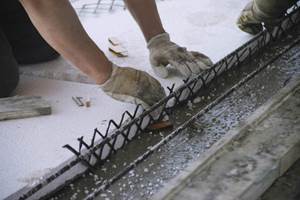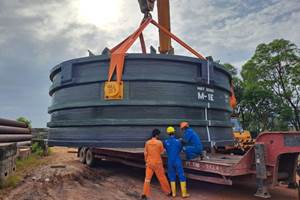Composites in infrastructure: IMAGINE that!
At the beginning of August, the Innovative Materials for America’s Growth and Infrastructure Newly Expanded (IMAGINE) Act was introduced to encourage research and use of innovative materials in infrastructure.
In late August, Bloomberg Business Week reported that the final eight miles of US Interstate 95, which stretches more than 1,900 miles from Maine to Miami, would open in September, more than 60 years after the law that authorized its construction, the 1956 National Interstate and Defense Highways Act. It is the last stretch of road to be funded under that legislation.
During those 62 years, many of America’s roads and bridges have seen significant wear and tear, due to the effects of weather and heavy traffic, with much of this infrastructure having to be rebuilt, shored up or restored. According to the US Department of Transportation, more than 61,000 bridges are currently classified as “structurally deficient” and in need of repair or replacement. The problem is not limited to the US, as evidenced by the tragic failure of the Morandi Bridge in Genoa, Italy in mid-August that killed 43 people. It is believed that corrosion of the steel reinforcement in the bridge, accelerated by sea air and, ironically, pollution from a nearby steel plant, resulted in the collapse during a heavy storm. Compounding the tragedy is that bidding on contracts to complete repairs to the bridge were in the process of being awarded.
Among the first things we learned about polymer composites is that they have superior corrosion resistance and improved weatherability compared to traditional construction materials like steel, concrete and wood. While the initial installation cost of composites (or composites-augmented solutions) might be higher than the incumbent materials and methods, their use reduces overall life cycle costs as composites-reinforced structures last two to three times as long and require less upkeep. Unfortunately, this view has not historically been supported by the government purchasers of infrastructure, with the focus on acquisition cost and hesitance to try new construction materials and techniques.
Until now, perhaps. At the beginning of August, bipartisan legislation was introduced in both the US House of Representatives and the Senate, under the title of the Innovative Materials for America’s Growth and Infrastructure Newly Expanded (IMAGINE) Act. As stated, the bill’s purpose is “to encourage the research and use of innovative materials and associated techniques in the construction and preservation of the domestic transportation and water infrastructure system.” Further goals are to accelerate deployment and extend the service life of infrastructure, a clear tilt toward life cycle considerations. Innovative materials, as defined by the bills, include high-performance asphalt mixtures, geosynthetic materials, advanced alloys and metals, reinforced polymer composites, and advanced polymers and coatings. A significant amount of credit for the introduction of this legislation goes to the American Composites Manufacturers Association (ACMA, Arlington, VA, US), which has worked tirelessly for years educating legislators on the advantages of composites in infrastructure.
The bill directs the formation of an interagency task force to assess infrastructure standards and identify barriers to the use of innovative materials, followed by a plan to overcome those barriers. It also directs the Department of Transportation to create Innovative Material Innovation Hubs, or research consortia between government labs, industry and universities, for the materials mentioned above. On the polymer composites side, a logical approach would be to extend the remit of the Institute for Advanced Composites Manufacturing Innovation (IACMI) into infrastructure applications, given that much of the supply community is already engaged with that institute.
The act is not limited to standards and research. It goes further, providing co-funding over the next five years of $60 million annually for innovative bridges spanning more than 50 ft. and $65 million annually for improved wastewater and drinking water systems. This co-funding should help municipalities or state highway agencies cover the additional initial costs of infrastructure projects incorporating composites, encouraging risk-taking in applying new materials. It will also provide case studies, intended to overcome the current intransigence to deploy composites, spurring market growth. As an industry, we already have a long history of successful applications in infrastructure — albeit not in widespread use — from fiberglass reinforcing rod in concrete structures to fully composite pedestrian bridges and cantilevered pedestrian walkways on conventional bridges, and relined sewers and water systems, supported with newly evolving building codes and specifications.
There is still a long road ahead, as the bills need to clear committee reviews, survive voting in both houses of Congress and be signed into law before the provisions can take place. ACMA is encouraging companies and the public to provide input to Congress to build broader support. Will this legislation be the catalyst that finally overcomes the barriers to composites adoption in infrastructure? One can hope. And imagine...
Related Content
Composites-reinforced concrete for sustainable data center construction
Metromont’s C-GRID-reinforced insulated precast concrete’s high strength, durability, light weight and ease of installation improve data center performance, construction time and sustainability.
Read MoreComposites reinvent infrastructure
Celebrating National Composites Week, CW shares ways in which composites continue to evolve the way we approach infrastructure projects.
Read MoreCCG meets customer demand with StormStrong utility pole lineup
Additional diameters build on the portfolio of resilient FRP pole structures for distribution and light pole customers.
Read MoreComposites end markets: Infrastructure and construction (2024)
Composites are increasingly used in applications like building facades, bridges, utility poles, wastewater treatment pipes, repair solutions and more.
Read MoreRead Next
“Structured air” TPS safeguards composite structures
Powered by an 85% air/15% pure polyimide aerogel, Blueshift’s novel material system protects structures during transient thermal events from -200°C to beyond 2400°C for rockets, battery boxes and more.
Read MoreDeveloping bonded composite repair for ships, offshore units
Bureau Veritas and industry partners issue guidelines and pave the way for certification via StrengthBond Offshore project.
Read MoreAll-recycled, needle-punched nonwoven CFRP slashes carbon footprint of Formula 2 seat
Dallara and Tenowo collaborate to produce a race-ready Formula 2 seat using recycled carbon fiber, reducing CO2 emissions by 97.5% compared to virgin materials.
Read More




















